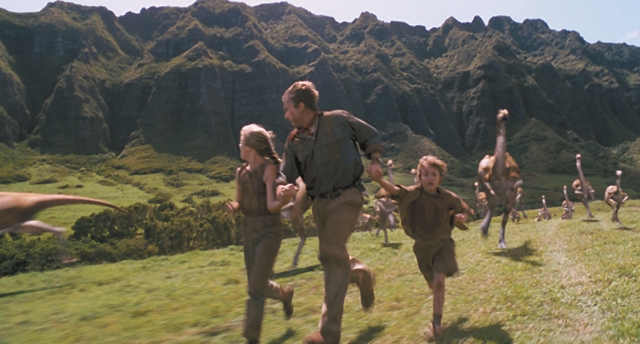Return to ‘Jurassic Park’ in 3-D

Take away the woefully rudimentary computers, Laura Dern’s mom jeans and Samuel L. Jackson’s hair, and it has all the trappings of a modern blockbuster.
Including the extra $3 or so you’ll have to fork over to see it the way it was intended.
Welcome to “Jurassic Park in 3D.”
Steven Spielberg’s dino-might tale of genetics run amok is back in theaters to celebrate its 20th anniversary. And, not having seen it in at least 15 of those years, it’s startling to discover just how impressively the late visual effects wizard Stan Winston’s creations have withstood the test of time.
From the rampaging tyrannosaurus to the sickly triceratops and the gentle brachiosaurus to the terrifying velociraptors, “Jurassic Park’s” dinosaurs still feel more viscerally alive than most every special effect that’s followed in the past two decades.
The return trip to Isla Nublar is a bit bumpy in places. The kids (Joseph Mazzello, Ariana Richards) are still annoying. It’s a hoot to see their jaws drop at the wonders of an SUV equipped with a touchscreen and an interactive CD-ROM. And, 20 years later, it’s even harder to watch the treacherous computer programmer played by Wayne Knight without wanting to disdainfully spit out, “Newman!”
In case you’ve been trapped in a hunk of amber, “Jurassic Park” takes place during a sneak preview of an isolated amusement park whose central attraction, a vast array of cloned dinosaurs, escapes during an act of sabotage.
Those kids, the park’s curator (Richard Attenborough), a paleontologist (Sam Neill), a paleobotanist (Dern) and a mathematician (Jeff Goldblum) spend the next hour fleeing for their lives.
Seeing Goldblum on the big screen once again, at the height of his Goldblum-iness, is a delicious treat.
The thing is, though, I’m tired of 3-D.
Sure, that extra dimension is great when it’s used as a filmmaking tool, the way it was wielded by, say, James Cameron on “Avatar,” Martin Scorsese on “Hugo” or Ang Lee on “Life of Pi.”
But, far too often, the use of 3-D is cynical at best.
While it’s officially being touted as a 20th birthday party, “Jurassic Park’s” 3-D conversion is as much an advertisement for the 3-D Blu-ray being released later this month and for the 3-D sequel due out in June 2014.
“Jurassic Park,” though, qualifies as a special event and can be forgiven its excesses.
On the other hand, last weekend’s “G.I. Joe: Retaliation” was delayed nine months so the filmmakers, who didn’t shoot it with 3-D in mind, could go back and add that extra dimension. The edict was passed down soon after executives saw the 2-D “Battleship,” based on another Hasbro property, sink to the bottom of the box-office charts.
The “G.I. Joe” move paid off because, as much as you or I may no longer be wowed by those plastic glasses, the rest of the world still gobbles up 3-D movies as though they were dipped in chocolate.
Take “Hansel & Gretel: Witch Hunters.” (Please.) The 3-D splatterfest was an afterthought in the U.S., earning just $55 million. But it raked in an additional $161 million at the foreign box office, spurring plans for a sequel — likely much to its star Jeremy Renner’s chagrin.
International audiences don’t even seem to care if the movies are new. According to boxofficemojo.com, last year’s 3-D re-release of “Titanic” earned $58 million during its entire nine-week domestic run, but it took in a staggering $67 million in China during its first week alone.
Not surprisingly, the Motion Picture Association of America now ranks China as the largest international film market, based on its $2.7 billion box office in 2012 (compared to $10.8 billion in the U.S. in Canada).
That comes on the heels of a November study by Ernst & Young that predicted China would overtake the U.S. as the world’s largest consumer of movies by 2020.
As long as there’s that kind of demand, Hollywood will keep cranking out 3-D movies.
Heck, even next month’s “The Great Gatsby” is being released in the format.
“Jurassic Park” remains an expertly crafted thrill ride that really doesn’t need the extra bells and whistles.
But, if nothing else, 3-D can give any movie — even bigger dung heaps than the one generated by that triceratops — what Hollywood blockbusters so often sorely lack.
Depth.
Contact Christopher Lawrence at clawrence@
reviewjournal.com or 702-380-4567.